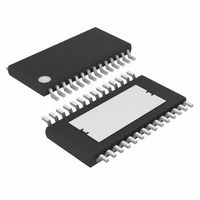MAX5051AUI+ Maxim Integrated Products, MAX5051AUI+ Datasheet - Page 16

MAX5051AUI+
Manufacturer Part Number
MAX5051AUI+
Description
IC PWR SPLY CNTRLR 28-TSSOP
Manufacturer
Maxim Integrated Products
Datasheet
1.MAX5051AUI.pdf
(21 pages)
Specifications of MAX5051AUI+
Pwm Type
Voltage Mode
Number Of Outputs
1
Frequency - Max
500kHz
Duty Cycle
48%
Voltage - Supply
11 V ~ 76 V
Buck
No
Boost
Yes
Flyback
Yes
Inverting
No
Doubler
No
Divider
No
Cuk
No
Isolated
Yes
Operating Temperature
-40°C ~ 125°C
Package / Case
28-TSSOP Exposed Pad, 28-eTSSOP, 28-HTSSOP
Frequency-max
500kHz
Lead Free Status / RoHS Status
Lead free / RoHS Compliant
Normally PVIN is derived from a tertiary winding of the
transformer. However, at startup there is no energy
delivered through the transformer, hence, a special
bootstrap sequence is required. Figure 6 shows the
voltages on PVIN, REG9, and REG5 during startup.
Initially, PVIN, REG9, and REG5 are 0V. After the input
voltage is applied, C21 (Figure 8) charges PVIN
through the startup resistor, R22, to an intermediate
voltage. At this point, the internal regulators begin
charging C3 and C4. The MAX5051 uses only 400µA
(typ) of the current supplied by R22, and the remaining
current charges C21, C3, and C4. The charging of C4
and C3 stops when their voltages reach approximately
5V and 9V, respectively, while PVIN continues rising
until it reaches the wakeup level of 24V. Once PVIN
exceeds this wakeup level, switching of the external
MOSFETs begins and energy is transferred to the sec-
ondary and tertiary outputs. When the voltage on the
tertiary output builds to higher than 9V, startup has
been accomplished and operation is sustained.
However, if REG9 drops below 6.2V (typ) before startup
is complete, the device goes back into standby. In this
case, increase the value of C21 to store enough energy
allowing for voltage buildup at the tertiary winding.
The PVIN bypass capacitor, C21, supplies current
immediately after wakeup (see Figure 8). The size of
C21 and the connection of the tertiary winding deter-
mine the number of cycles available for startup. Large
values of C21 increase the startup time and supply
gate charge for more cycles during initial startup. If the
value of C21 is too small, REG9 drops below 6.2V
Parallelable, Clamped Two-Switch
Power-Supply Controller IC
Figure 6. PVIN, REG5, and REG9 During Startup in
Bootstrapped Mode
16
______________________________________________________________________________________
40ms/div
Startup Time Considerations
PVIN
10V/div
REG9
5V/div
REG5
5V/div
because the MOSFETs did not have enough time to
switch and build up sufficient voltage across the tertiary
output to power the device. The device goes back into
standby and will not attempt to restart until PVIN rises
above 24V. Use a low-leakage capacitor for C21, C3,
and C4 (see Figure 8). Generally, power supplies keep
typical startup times to less than 500ms even in low-line
conditions (36VDC for telecom applications). Size the
startup resistor, R22 (Figure 8) to supply both the maxi-
mum startup bias of the device and the charging cur-
rent for C21, C3, and C4.
The MAX5051 oscillator is externally programmable
through a resistor and capacitor connected to RCOSC.
The PWM frequency will be 1/2 the frequency at RCOSC
with a 50% duty cycle, and is available at SYNCOUT.
The maximum duty cycle is limited to < 50% by a 60ns
internal blanking circuit in the power drivers in addition
to the gate and driver delays.
Use the following formula to calculate the oscillator
components:
where C
(about 14pF), REG5 = 5V, V
level, and f
The MAX5051 contains circuitry that allows it to be syn-
chronized to an external clock whose duty cycle is 50%.
For proper synchronization, the frequency of this clock
should be 15% to 20% higher than half the RCOSC fre-
quency of the MAX5051’s internal oscillator. This is
because the external source SYNCIN directly drives the
power stage, whereas the internal clock is divided by
two. The synchronization feature in the MAX5051 has
been designed primarily for two devices connected to
the same power source with a short physical distance
between the two circuits. Under these circumstances,
the SYNCOUT from one of the circuits can be connect-
ed to the SYNCIN of the other one; this forces the power
cycle of the second unit to be 180° out-of-phase. To
synchronize a second MAX5051, feed the SYNCOUT of
the first device to the SYNCIN of the second device. If
necessary, many devices can be daisy-chained in this
manner. Each device will then have 180° phase differ-
ence from the device that drives it.
R
RCOSC
PCB
s
is the switching frequency.
≈
is the stray capacitance on the PC board
2
Oscillator and Synchronization
f C
s
(
RCOSC
+
TH
C
PCB
is the RCOSC peak trip
1
)
In
REG
REG
5
−
5
V
TH












